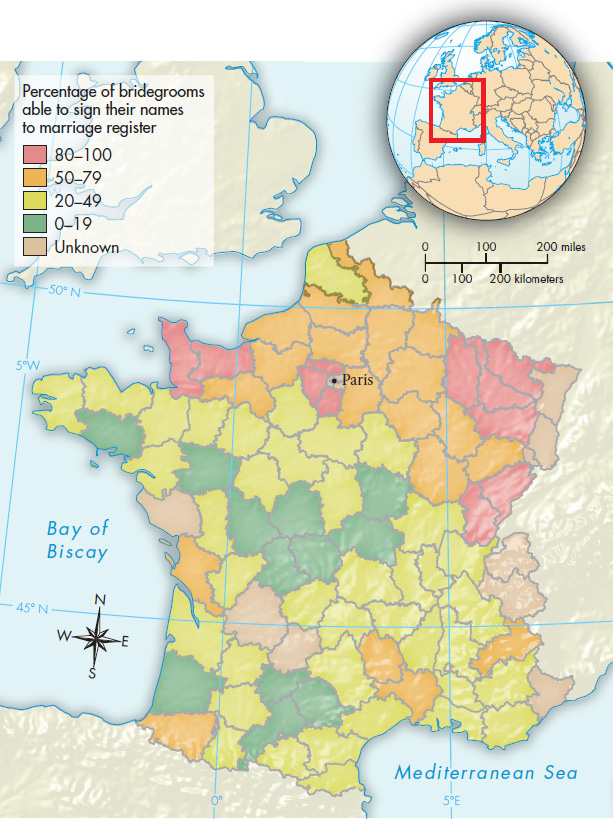Popular Literature
The surge in childhood education in the eighteenth century led to a remarkable growth in literacy between 1600 and 1800. Whereas in 1600 only one male in six was barely literate in France and Scotland, and one in four in England, by 1800 almost nine out of ten Scottish males, two out of three French males (Map 18.1), and more than half of English males were literate. In all three countries, the bulk of the jump occurred in the eighteenth century. Women were also increasingly literate, although they lagged behind men.
MAPPING THE PAST

ANALYZING THE MAP What trends in French literacy rates does this map reveal? Which regions seem to be ahead? How would you explain the regional variations?
CONNECTIONS Note the highly variable nature of literacy rates across the country. Why might the rate of literacy be higher closer to the capital city of Paris? Why would some areas have low rates?
The growth in literacy promoted growth in reading, and historians have carefully examined what the common people read. While the Bible remained the overwhelming favorite, especially in Protestant countries, short pamphlets known as chapbooks were the staple of popular literature. Printed on the cheapest paper, many chapbooks featured Bible stories, prayers, and the lives of saints and exemplary Christians. This pious literature gave believers moral teachings and a faith that helped them endure their daily struggles.
Entertaining, often humorous stories formed a second element of popular literature. Fairy tales, medieval romances, true crime stories, and fantastic adventures were some of the delights that filled the peddler’s pack as he approached a village. These tales presented a world of danger and magic, of supernatural powers, fairy godmothers, and evil trolls, that provided a temporary flight from harsh everyday reality. They also contained nuggets of ancient folk wisdom, counseling prudence in a world full of danger and injustice, where wolves dress like grandmothers and eat Little Red Riding Hoods.
Finally, some popular literature was highly practical, dealing with rural crafts, household repairs, useful plants, and similar matters. Much lore was stored in almanacs, where calendars listing secular, religious, and astrological events were mixed with agricultural schedules, arcane facts, and jokes. The almanac was highly appreciated even by many in the comfortable classes. In this way, elites still shared some elements of a common culture with the masses.
While it is safe to say that the vast majority of ordinary people — particularly peasants in isolated villages — did not read the great works of the Enlightenment, they were not immune from the new ideas. Urban working people were exposed to Enlightenment thought through the rumors and gossip that spread across city streets, workshops, markets, and taverns. They also had access to cheap pamphlets that helped translate Enlightenment critiques into ordinary language. Servants, who usually came from rural areas and traveled home periodically, were well situated to transmit ideas from educated employers to the village.
Certainly some ordinary people did assimilate Enlightenment ideals. Thomas Paine, author of some of the most influential texts of the American Revolution, was an English corset-maker’s son who left school at age twelve and carried on his father’s trade before emigrating to the colonies. His 1776 pamphlet Common Sense attacked the weight of custom and the evils of government against the natural society of men. This text, which sold 120,000 copies in its first months of publication, is vivid proof of working people’s reception of Enlightenment ideas. Paine’s stirring mastery of them was perhaps unique, but his access to them was certainly not.